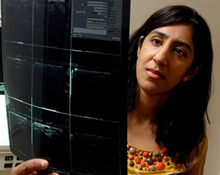Research
March 1, 2010
Sound Science: Surgery without the steel

Cynthia Anderson
Listen to Cynthia Anderson on Sound Science.
When Cynthia Anderson prepares her patients for stereotactic radiosurgery she emphasizes three things. The surgery is fast, friendly and focused.
"Stereotactic radiosurgery is fast because the actual radiation treatment itself is very short," says Anderson, a radiation oncologist at the Winship Cancer Institute. "It's friendly because it's all done as an outpatient. And it's focused because these are the most targeted radiation beams to get the maximum dose of radiation to a tumor and give the most minimal dose of radiation to the critical organs that surround the tumor."
Initially used to treat the part of the brain associated with brain tumors, stereotactic radiosurgery has gained currency as a treatment for various types of cancer. Surgeons use x-ray beams instead of scalpels to eliminate tumors of the liver, lung and spine.
To listen to Anderson's own words about stereotactic radiosurgery and its uses, access Emory's latest Sound Science podcast. Stereotactic radiosurgery is actually a combination of surgical principles, says Anderson. But because it uses radiation, there's no incision, no anesthesia and no trip to the operating room; hence, no hospitalization.
And its capability to noninvasively eliminate spinal tumors has made it an ideal way to deliver palliative care to patients whose cancer has metastasized to the spine, a source of acute pain.
"Patients who have metastatic cancer often have more symptoms than those who have early stage cancer," says Anderson. "They're more likely to have pain, and they're more likely to have debilitating side effects from wherever the tumor has spread. And even though they will require chemotherapy to ultimately treat the entire burden of their disease, it's quite possible they have one area that's especially symptomatic."
Anderson and her colleague, Costas Hadjipanayis, are launching a neuro-oncology clinic where stereotactic radio surgery will be used in spinal surgery. The clinic, says Anderson, will embody a collaborative effort between radiation oncology and neurosurgery.
"There are some important frontiers that we're learning to bridge right now in oncology," says Anderson. "One is more individualized care where we are not treating all breast cancers or lung cancers or colon cancers the same. That philosophy is also being applied to patients who are in need of palliative care. Palliative care is getting a lot more attention and respect because patients live longer with cancer, and those who have advanced disease understand that they may no longer be curable, but they don't want to lose their quality of life."
Anderson received her MD and completed her radiation oncology residency at Emory, where she served as chief resident in her final year. She has conducted research testing radiosurgery and evaluating new therapies for patients with brain and spinal tumors and gastrointestinal cancers. While in training at Emory, she published several peer-reviewed research papers on prostate and rectal cancer patient outcomes as well as on tumor imaging.
